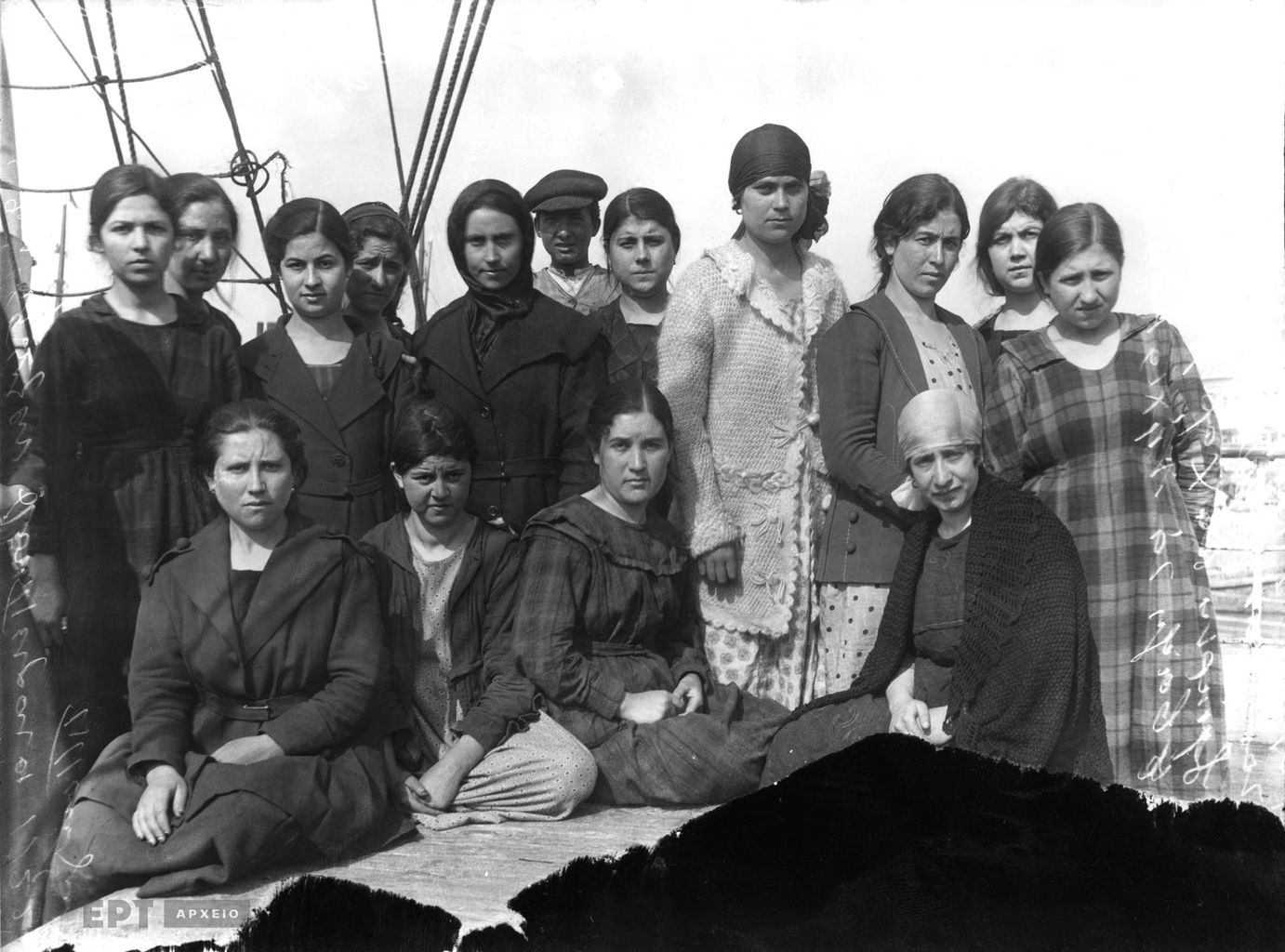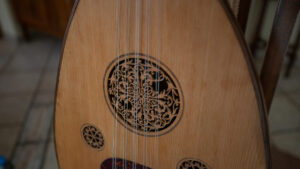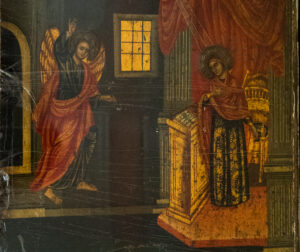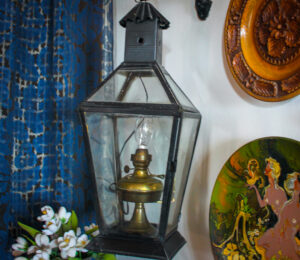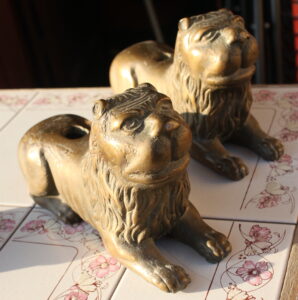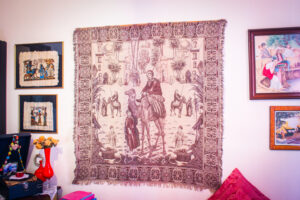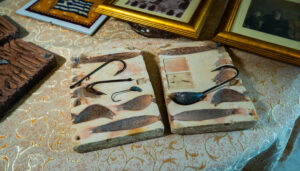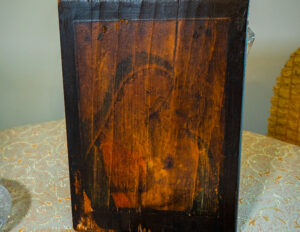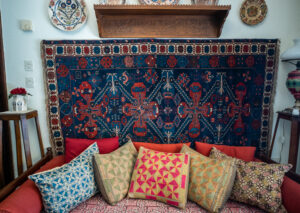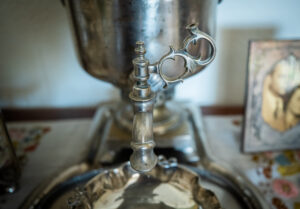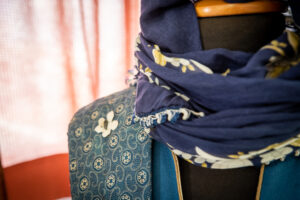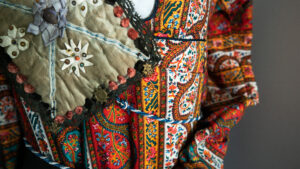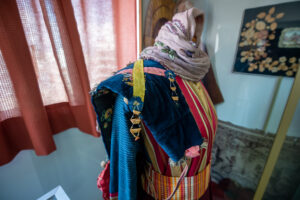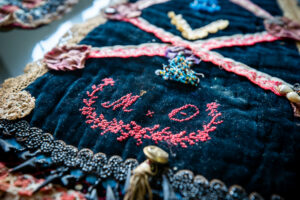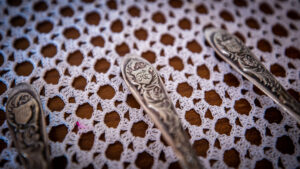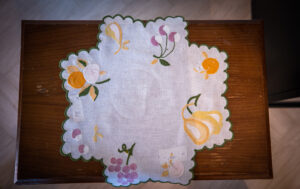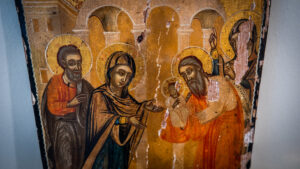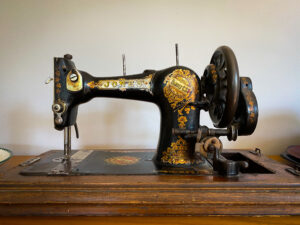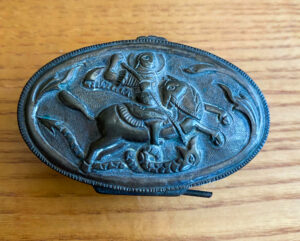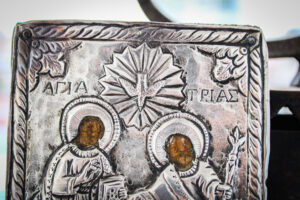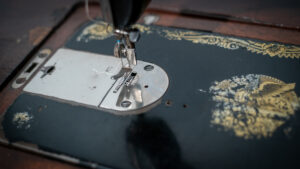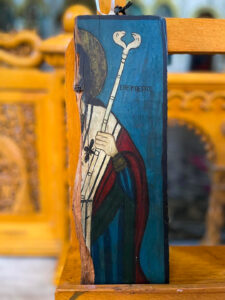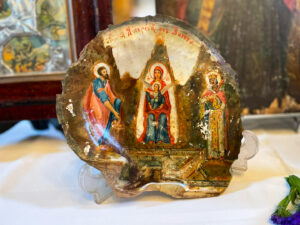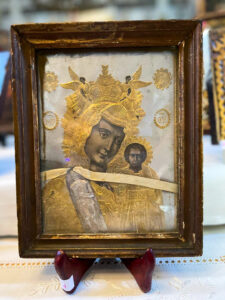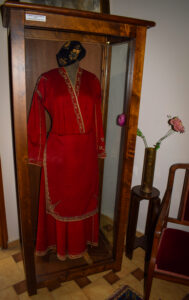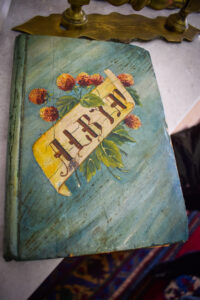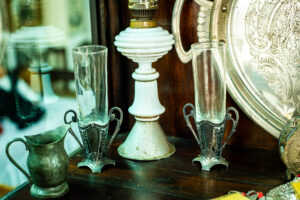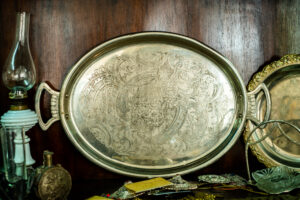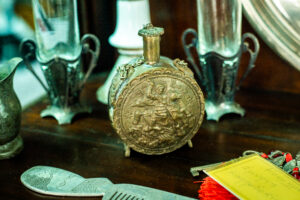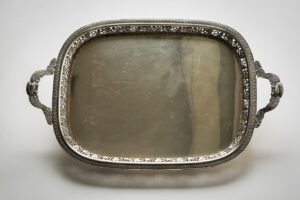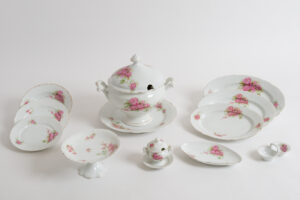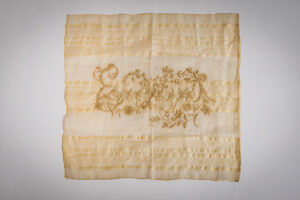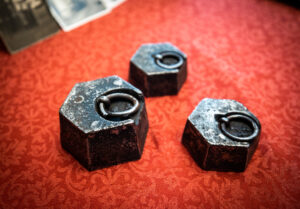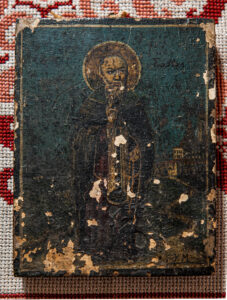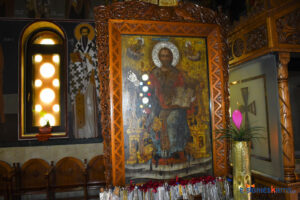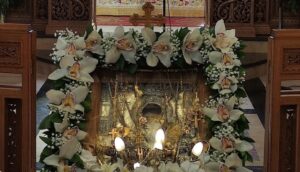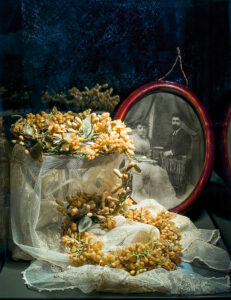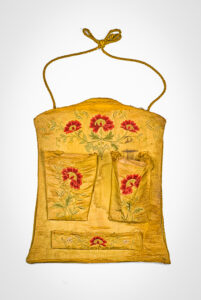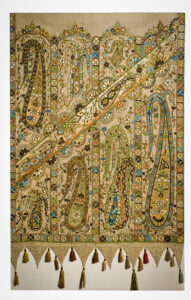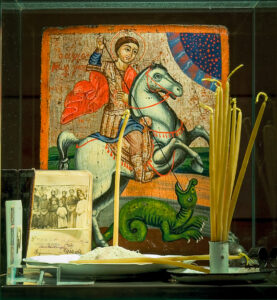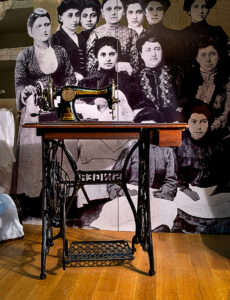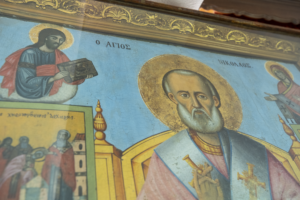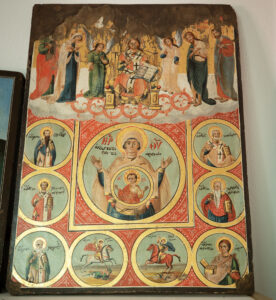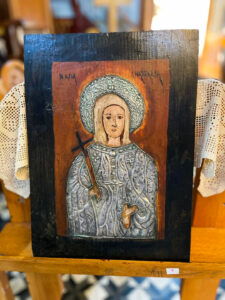Vasilis Kaptanoglou was born in Prokopi, Cappadocia, in 1907. At the beginning of 1922, he arrived in Piraeus with his mother and stayed in a makeshift shack in Tampouria with his brother’s family, who had arrived a few months earlier. Throughout his life, he never stopped playing the oud, the same one he had brought with him from Prokopi.
Amid the makeshift shacks of Tampouria, Vasilis met Eleni Dimou from Chili on the Euxine Sea, another refugee who had arrived in Greece with her father and her two sisters. This icon of the Annunciation, originating either from Prokopi or Chili, holds immense sentimental value for their descendants.
Giorgos Papagiovanoglou, a wool merchant, was originally from Sungurlu, a town located between Ankara and Cappadocia. At the outbreak of the Asia Minor conflict, he found refuge in Constantinople and, then, in Ano Poli, Thessaloniki. He married Tarsi Vlisidou and the couple had twins in 1943. At the time, there was a curfew and a blackout in the German-occupied city. Using the lantern that the family had brought with them form Sungurlu, Tarsi and a neighbour lit their way towards the Anagnostaki clinic where Tarsi gave birth.
At the outbreak of the Asia Minor conflict, Giorgos Papagiovanoglou found refuge in Constantinople, leaving his two sons behind, in Sungurlu, to reunite with the rest of the family later. After selling their entire wool stock, they arrived in Thessaloniki carrying a great amount of household effects and relying on their savings in English banks to rebuild their life. They resettled in a large Turkish house in Terpsithea Square in Ano Poli which they eventually bought.
Odysseas Papaioannou, one of the twin grandsons of Giorgos Papagiovanoglou, grew up in Ano Poli in the house of Terpsithea Square. He grew up rich surrounded by great poverty and the resulting tension profoundly shaped his personality. He left the family home for a few years, but returned to it, restored it and preserved a number of the household items brought to Greece by his grandfather’s family. Among them, this tapestry with an oriental theme.
Georgios Trechas and Konstantinos Raspitsos were born at the end of the 19th century on Englezonisi, a small island in the Gulf of Smyrna with a population of around 2,500 people, mainly Christians. From a very young age, they started working as fishermen to provide for their families. Two stone moulds for fishing hooks, today in the possession of Konstantinos Trechas, Georgios’ grandson, are some of the few belongings they brought with them to Greece.
In October 1924, the women of Sinasos brought their traditional outfits with them to Greece, as they considered them highly valuable both from a material and a sentimental standpoint. Some women even wore them during their first years in Greece before they were ‘hidden’ in closets for years to eventually be donated, usually by descendants, to the ‘Nea Sinasos’ Association Museum, where they are still kept to this day.
The women of Sinasos did not dance in public spaces, but only during private feasts in their homes and always accompanied by their fathers or husbands. During these feasts or other formal functions and celebrations, they would wear their ‘special’ traditional outfit, their version of formal wear.
The young women of Sinasos went to the water pumps to fill their clay pots with water for everyday household use. To protect the shoulders of their painstakingly constructed outfits from wear, they placed an ‘archaletsi’ over their right shoulder, a handmade cloth cover which they had usually made themselves.
The ‘archaletsi’ could be plain or decorated, adorned with patterns, embroideries, charms, beads or other ornaments. The fact that these shoulder covers were detachable and were worn every day allowed their makers to create elaborate versions that could act as accessories to the traditional women’s outfit which was usually quite conservative in its use of colour and pattern.
Charoula Panagiotidou has kept objects brought to Greece by her mother’s family. She still uses all of them in her everyday life and shares their stories with her children and grandchildren in an effort to keep the history of her family alive and preserve the memory of the house, the village, and the life they left behind.
Alexandros Oustampasidis and Anastasios Polychroniadis received a special permit from the Revolutionary Government and the Ministry of Hygiene allowing them to rent a boat and sail from Thessaloniki in order to reunite the refugees originating from the wider area of Amisos and assist with their resettlement in Macedonia. During one of these trips, Anastasios Polychroniadis was finally able to reunite with his own family, his wife, and his two children and they all returned to Thessaloniki. His wife, Elisavet Alsanoglou, brought with her this sewing machine.
Even though she had already sold most of her valuables to help her husband flee to Greece, Elisavet Alsanoglou still managed to bring with her a few objects which carried significant emotional or practical value. Eventually, what was handed down to her daughter, Maria, was a sewing machine, some kilim rugs, and a small silver box with the icon of Agios Georgios. These objects are today in the possession of Elisavet’s granddaughter, Martha Karpozilou.
The family of Kyriakoula Moschou brought few items with them to Greece, mostly religious icons. Apart from carrying great value for their owners, these icons soon became symbols for the whole neighbourhood. They gave hope and instilled courage, helping the refugees cope with the hardships of their everyday life. The icons did not just stand for their faith in God, but were also symbols of the solidarity and the kindness that brought the neighbourhood’s residents together.
This sewing machine, which is still functional, encapsulates the entire story of the Michailidou family’s movement from Pontus to Russia and then to Greece. Anastasia Michailidou chose to carry this heavy and cumbersome object on this long journey, highlighting the practicalities and material choices that migrants have been faced with throughout history.
Half of an icon of Agios Eleftherios survives in Chania. We can see half the body of a saint dressed in blue, green, red and white holding a sceptre. The face of the saint is missing, but the name ‘Eleftherios’ remains. The wood on which the figure of the saint has been painted has been torn in half.
On her father’s side, Gogo Rakopoulou hails from Prousa, while on her mother’s side, her ancestors were originally from Smyrna. Their original surname is not known, since they adopted the surname ‘Tsichlakis’ upon their arrival in Chania. These four icons travelled with them and, after the family had settled in Greece, they adorned their homes and, later, their descendants’ homes.
Ourania Stamatiadou-Koutsogianni, the granddaughter and namesake of Ourania Stamatiadou, is a retired educator and the chairwoman of the ‘Englezonisi’ Cultural Association of Asia Minor Greeks of Nea Ionia, Magnisia. She is overwhelmingly generous with stories of her family and the rest of the Englezonisi refugees. Besides sharing her narratives, she also keeps two small vases brought to Greece by her family on a small display at the association’s offices.
A silver tray, two small vases and a silver flask engraved with the icon of Agios Georgios are all the belongings Ourania Stamatiadou-Koutsogiannis’ grandparents managed to bring with them to Greece. These objects are part of her family history, but also of the history of all refugees. Ourania believes that their value lies in their ability to disseminate and preserve refugee history.
For Ourania Stamatiadou-Koutsogianni, the story of her grandparents, starting with their origins, then their exodus and the new life they built at the refugee neighbourhoods of Nea Ionia, is part not only of her family history, but also of the history of Asia Minor Hellenism in general, of the refugee movement of 1922 and the new refugee settlements which sprung up all over the country.
From grocery shop owner in Vatum, Pontus, to travelling greengrocer in Piraeus, Georgios Tsouchnikas and his family became refugees twice, both times carrying along their few possessions. Among them were these scale weights; important work tools, but also reminders of the shops he left behind and proof of his hope that he would be using them in his new life.
Savvas Leptourgidis, a retired journalist, was born in 1948 in the American Women’s Hospital in Kokkinia and grew up in Keratsini, in the refugee neighbourhood of Amfiali, where he still lives. This icon of Agios Savvas is not only a part of his own and his family’s past, but also a piece of his homeland’s culture.
Refugees from Alikarnassos in Asia Minor arrived at Heraklion in Crete and founded the settlement of Nea Alikarnassos. There are two churches serving the needs of the community, Agios Nikolaos and Panagia Kamariani, built later. The church of Agios Nikolaos was founded by the refugees soon after their arrival and it was originally a wooden construction.
The Museum of the Pontian Women’s Association, called ‘Embroidering memory’, was inaugurated in 2005. Several of the objects in its collection came from Pontus and Russia, traversing space and time. Among them, the embroidered hairbrush case of Elisavet Theodoridou (nee Grammatikopoulou) which came from Kars, Russia.
The Museum of the Pontian Women’s Association, called ‘Embroidering memory’, was inaugurated in 2005. Several of the objects in its collection came from Pontus and Russia, traversing space and time. Among them, an embroidery from Trapezounta known as a ‘kourtinaki’ or ‘keimilio’, one of the two curtain panels covering an icon display embroidered in a paisley pattern (lahuri in Turkish), a pattern widely used in Pontus.
The Museum of the Pontian Women’s Association, called ‘Embroidering memory’, was inaugurated in 2005. Several of the objects in its collection came from Pontus and Russia, traversing space and time. Among them, a Singer sewing machine, first used in Trapezounta, in 1911, and then in Thessaloniki.
